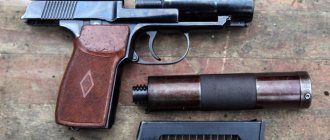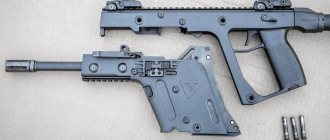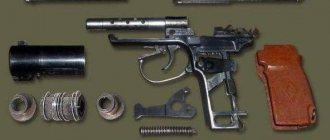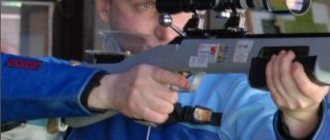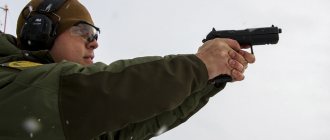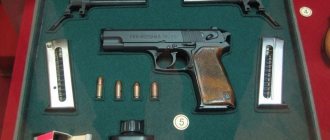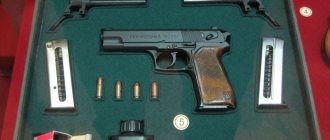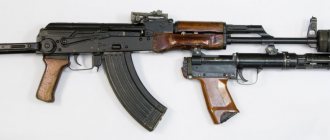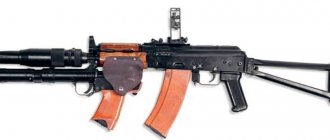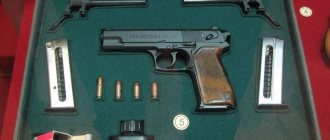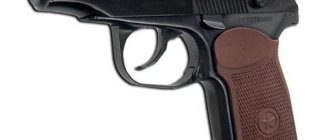Each military operation requires certain characteristics from personal small arms. For example, in an open attack, the main parameters are power, rate of fire and lethal force. If a hidden action is intended, the weapon should create as little noise as possible.
Especially for such purposes, Soviet and then Russian designers created low-noise modifications, in particular silent pistols. And one of the brightest representatives of this type of weapon is the PB (GRAU 6P9).
History of the creation of PB
The rethinking of tactical combat schemes after the Great Patriotic War led to the realization of the need to develop and introduce more advanced low-noise weapons than those already available.
This was especially important for reconnaissance and sabotage units. The ability to interfere with the enemy and determine the direction of the shot is also in demand when setting up ambushes or during combat at night.
The first sign was the creation in 1954 of the PBS silencer (the full name of the PBS is a device for silent, flameless shooting).
This device was developed and produced for the 7.62*39mm cartridge caliber, that is, for machine guns, carbines and machine guns.
For its effective use, special ammunition with the US index was used. They had a reduced initial speed, or rather subsonic. At the end of the 60s, for various reasons, it was decided to abandon the use of PBBS on light machine guns (RPD) and carbines (SKS).
However, under certain conditions, the use of these small arms was inappropriate - they were too bulky and noticeable. In these cases, the ideal option would be a pistol with reduced noise generation.
Work on the creation of such weapons was started by A.A. Deryagin, a talented Soviet designer, in the early 60s at the Central Research Institute Tochmash. He used the then popular PM (Makarov pistol) as a basis.
However, it is impossible to say that one is a modification of the other - the design of the weapon has undergone more than serious reworking. In fact, all that remained from the original PM was the trigger mechanism (also subject to modifications) and the magazine.
A prototype was provided by Deryagin in 1967. In the same year, it passed successful field and bench tests, after which it was put into service under the designation 6P9 or 6PB-9.
Reviews
According to the military who use this silent pistol, this model has the following advantages:
- High service strength and durability.
- Shooting accuracy. Unlike the Makarov pistol, the PB has a large mass. His excess weight has a positive effect on the accuracy of the battle. According to the military, during shooting the weapon does not throw up so much from the line of fire, which cannot be said about the PM. In addition, the PB is characterized by lower recoil, which is especially important during high-speed shooting.
- The silent pistol is highly balanced. According to some users who picked up this model for the first time, they had the feeling that the gun would “peck” at the barrel. However, during use, they were pleasantly surprised: the PB fits perfectly in the hand.
Despite the fact that this silent pistol has established itself as a very high-quality and reliable example of small arms, according to reviews from military personnel who use the PB, it has the following disadvantages:
- Availability of manually controlled fuse.
- Metal parts in the pistol collide loudly when firing
- Weapons without a silencer installed on the barrel are not suitable for silent use. According to users, every time you need to shoot quietly, you have to mount a removable attachment to the weapon.
During the operation of the PB, it was noticed that in cases where the fire from the PB is carried out in series of six shots, the sound becomes stronger. If the shooting is carried out slowly, then the sound remains unchanged.
Design
Taking the PM as a basis, Deryagin subjected all its parts to a deep modernization, so the PB cannot be called a modification of this pistol - it is a completely independent system.
Since part of the barrel is a built-in silencer, the bolt-casing of the weapon had to be seriously shortened.
This entailed a change in the position of the return spring, which is now located in the handle, and in the vertical plane
Its operation and connection with the shutter itself is carried out through a special lever element, the design of which is “seen” from the Parabellum.
The 6P9 has a two-section muffler. Its first part is a component of the barrel and is an expansion chamber equipped with a special metal mesh. Its task is to quickly cool the gases formed during the combustion of gunpowder as a result of a shot.
Their entry into the chamber is ensured by special holes in the rifling fields, which is designed to ensure optimal removal of powder gases at the moment the shot is fired.
The edge of the built-in muffler has a special thread for attaching the nozzle. The nozzle is a removable muffler, inside of which there is a separator of a special design. The latter consists of a set of washers installed inside at different angles relative to the barrel.
They split the gas flow into several small ones and give them a “swirl”.
The additional weight of the barrel acquired by the attachment does not interfere with shooting at all - it creates a greater margin of stability due to reduced barrel toss.
All this contributes to a significant reduction in noise when fired. The second component of the volume reduction was the reduction in bullet speed to the subsonic threshold - in the PM it is 290 m/s. With this indicator, the bullet does not have the ability to create a serious shock wave, which, naturally, is reflected in the sound of the shot.
Thanks to all these design features, sound suppression when firing is considered quite effective. However, it cannot be called completely silent.
The movement of contacting metal parts creates a characteristic sound that can be heard at a distance of up to 50 meters in a quiet environment. This feature of the PB must be taken into account when using it at night, especially in open areas.
For firing from 6P9, special 9-millimeter ammunition is used, which has received the US index. The initial speed of such bullets is below the speed of sound. The magazine capacity is 8 rounds.
Advantages and disadvantages of 6P9
The Silent 6P9 pistol is a very specific weapon, created for the work of special forces and assault groups of law enforcement agencies. Therefore, it has a lot of advantages and disadvantages.
pros
Due to its weight and shape, the pistol is well balanced and there is almost no recoil felt when firing.
Some unification with the Makarov pistol made it possible to launch production of the model at IzhMekh in a short time
The product has a large margin of safety. According to some reports, the pistol is capable of operating even at twice the guaranteed fire rate.
The sound of the shot will spread within a radius of 50 meters from the shooter
Possibility of shooting with the silencer removed
Use of 9x18 PM cartridges as standard ammunition
Minuses
The pistol has a large mass of 1.2 kilograms
The length with the attached silencer does not allow the 6P9 to be carried covertly. To do this, you have to turn off the PBS, which significantly enhances the sound of the shot.
With several shots in a row, the effectiveness of the silencer decreases, and the sound of the shot begins to resemble that of the PM
The external muffler must be turned off when worn and stored in a special case
The pistol has a tight return spring, which leads to the need to apply more force to cock the BB into the firing position
Due to the small size of the shutter-casing, the self-cocking mechanism was complicated due to additional transmission parts
The cost of one product reaches 70,000 rubles, which is several times more expensive than the price of PM
Specifications
The performance characteristics of the PB silent pistol (GRAU 6P9/6PB-9) are contained in the following table:
| Magazine capacity | 8 rounds |
| Number of cartridges in full equipment | 9 (1 cartridge per barrel) |
| Type of ammunition used | 9*18mm (PM-US) |
| Sighting range | up to 25m / up to 50m |
| Rate of fire | 30 min. |
| Initial bullet speed | 290m/s |
| Weight | 950g (without cartridges), 1120g (loaded) |
| Length | 310mm (with muffler), 170mm (without muffler) |
| Height and width | 134*32mm |
| Barrel length | 100mm |
Areas of use
The main customers of the PB silent pistol were reconnaissance and reconnaissance and sabotage units of the troops. For example, among GRU (Main Intelligence Directorate) special forces fighters, the presence of 6P9 in their equipment has become mandatory.
The KGB became another regular customer of weapons, especially after the appearance in their ranks of such special units as “Alpha” and “Vympel”. In addition, different departments can order silent pistols for specialized purposes.
For example, the Belarusian Ministry of Internal Affairs purchases the model in question for the execution of death sentences.
Production of the 6P9 was discontinued in 1987 in favor of new types of silent pistols. However, in 2003, the Izhevsk Mechanical Plant resumed production of PB.
Many experts recognized that ease of maintenance and use, as well as the use of common ammunition, more than compensated for all the shortcomings of the pistol. The scope of application after this, of course, did not change.
Other models of silent pistols
In addition to the PB, the domestic arms industry has created several more models positioned as silent or silenced pistols. One of the first was the C4, developed back in the 60s.
The pistol had two barrels located in a vertical plane and used ammunition of 7.62*63mm PZ caliber, and later 7.62*63mm PZAM. On their basis, the SME was developed - the Small-sized special pistol "Groza", also designated 6P24 and TOZ-37.
This model was adopted into service in 1972. The design of the pistol implied the use of a closed-type cartridge SP-3. It was withdrawn from service due to the development of more advanced ammunition of this type and weapons for it.
Speaking about silent weapons, one cannot fail to mention the APB (Automatic Silent Pistol), developed on the basis of the famous APS.
Its quiet operation was achieved through the use of a specially created removable muffler and an expansion chamber under the casing.
It was possible to use it in automatic firing mode, just like the APS. He was especially popular among special forces soldiers. Ceased to be produced due to the high cost of production and maintenance, but is still actively used by special forces soldiers.
All of these models have certain disadvantages. They were taken into account when designing the PSS (Special Self-Loading Pistol), developed in the late 70s and early 80s. This model was one of the last to be adopted - in 1983.
A new type of ammunition with gases locked inside the SP-4 cartridge case was developed especially for it. Now it is gradually being replaced by a modified version of the PSS-2, which has even more impressive characteristics. However, in several respects it still loses to PB - ease of maintenance and manufacturing cost.
Among the developments of domestic designers there is also a silent revolver - OTs38 (special Stechkin revolver).
It uses special 7.62mm ammunition with internal gas locking, which ensures a silent shot.
Amplifier circuit
The diagram of one channel of a stereo amplifier with a power supply is shown in Fig. 1. This is a single-ended power amplifier with two pentodes connected in parallel, without feedback, with a fixed bias, providing an anode current of each lamp of 30 mA. You can also use automatic offset.
To do this, a resistor with a resistance of 68 ... 100 Ohms (selected for each lamp according to the anode current) with a power of 0.5 W should be included in the cathode circuit of each lamp, shunted by an oxide capacitor with a capacity of 500 ... 1000 μF for a rated voltage of 16 V.
The sound largely depends on the quality of this capacitor. In this case, the third grid is connected to the cathode, and the lower output of the VD7 zener diode according to the diagram must also be connected there.
The 6P9 pentode at the UMZCH output is a definite challenge to modern ideas, according to which it is believed that good sound can be obtained by using only triodes or pentodes and tetrodes in a triode connection.
Indeed, the triode is more linear and its internal resistance is lower (correspondingly, the inductance of the primary winding of the output transformer is lower).
But the maximum output power of such an amplifier on the 6P9 is reduced, and the sensitivity also decreases. On the other hand, there are many supporters of pentode amplifiers who claim that musical works of certain genres sound better with pentode amplifiers.
In addition, the main advantage of the described amplifier is that it is single-stage, and switching the lamps to triode mode will require a second amplification stage. And it’s difficult to say for sure what will sound better: a two- or three-stage UMZCH on a triode or a single-stage on a pentode [4].
It should be noted that when connecting lamps in parallel, their selection is required. After all, in such an amplifier the lamps work as if in a “duet”. And the result largely depends on how well they are selected; it’s not difficult to do this yourself, having the opportunity to choose them: 6P9 is not an expensive lamp.
The main difference between the amplifier circuit in Fig. 1 from that given in (3] is the presence of a voltage stabilizer for the second (screening) grid. Control listening showed that the introduction of a stabilizer noticeably improved the sound.
The fact is that the linearity of the pentode very much depends on the stability of the voltage on the second grid, and at large signal amplitudes the voltage on the second grid also begins to change. The filter capacitor between the grid and the common wire does not always cope with this phenomenon (at the lowest frequencies).
Rice. 1. Schematic diagram of a tube amplifier using 6P9 tubes.
This design uses a parametric stabilizer on six KS524G zener diodes and one KS512A for a total voltage of 150 V. The zener diode circuit is shunted by MBGO capacitors with a capacity of 4 μF and an oxide capacitor with a capacity of 100 μF for 160 V (Jamicon).
Instead of a zener diode circuit, you can use one KS650A. In this case, for two channels it is necessary to select two with the required stabilization voltage and install them on heat sinks (power dissipation - 1.5...2 W).
A stable voltage for the second grid can also be provided with a tube (on SPZP) or transistor stabilizer. Resistors R3, R4 in the anode circuits serve to control the anode current during setup. The voltage drop across them in millivolts is numerically equal to the anode current in milliamps. Once established, they can be eliminated.
Power switch SA1 is connected in series with the mains winding of the transformer. To increase the service life of the lamps, in order to protect them from the supply of anode voltage in an unheated state, another switch SA2 is installed directly in the anode voltage circuit.
